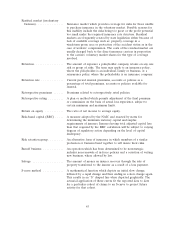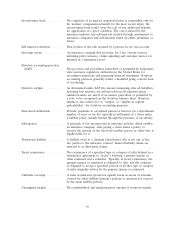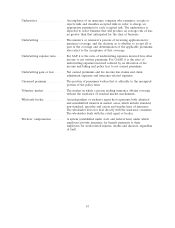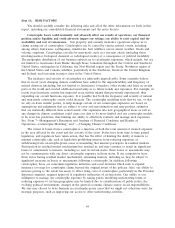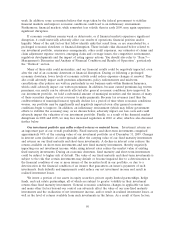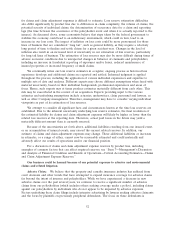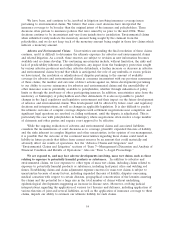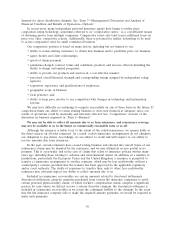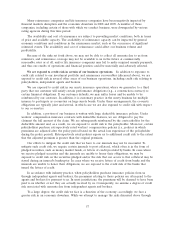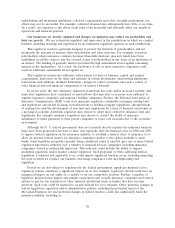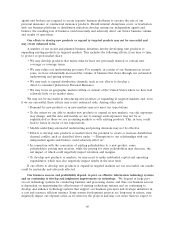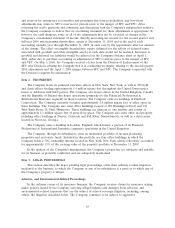Travelers 2009 Annual Report Download - page 65
Download and view the complete annual report
Please find page 65 of the 2009 Travelers annual report below. You can navigate through the pages in the report by either clicking on the pages listed below, or by using the keyword search tool below to find specific information within the annual report.primarily the result of the number of traditional asbestos defendants who have sought bankruptcy
protection in previous years. In addition to contributing to the overall number of claims, bankruptcy
proceedings may increase the volatility of asbestos-related losses by initially delaying the reporting of
claims and later by significantly accelerating and increasing loss payments by insurers, including us. The
bankruptcy of many traditional defendants has also caused increased settlement demands against those
policyholders who are not in bankruptcy but that remain in the tort system. Currently, in many
jurisdictions, those who allege very serious injury and who can present credible medical evidence of
their injuries are receiving priority trial settings in the courts, while those who have not shown any
credible disease manifestation are having their hearing dates delayed or placed on an inactive docket.
This trend of prioritizing claims involving credible evidence of injuries, along with the focus on
previously peripheral defendants, contributes to the claims and claim adjustment expense payments we
have experienced. Our asbestos-related claims and claim adjustment expense experience also has been
impacted by the unavailability of other insurance sources potentially available to policyholders, whether
through exhaustion of policy limits or through the insolvency of other participating insurers.
We continue to be involved in coverage litigation concerning a number of policyholders, some of
whom have filed for bankruptcy, who in some instances have asserted that all or a portion of their
asbestos-related claims are not subject to aggregate limits on coverage. In these instances, policyholders
also may assert that each individual bodily injury claim should be treated as a separate occurrence
under the policy. It is difficult to predict whether these policyholders will be successful on both issues.
To the extent both issues are resolved in a policyholder’s favor and our other defenses are not
successful, our coverage obligations under the policies at issue would be materially increased and
bounded only by the applicable per-occurrence limits and the number of asbestos bodily injury claims
against the policyholders. Accordingly, although we have seen a moderation in the overall risk
associated with these lawsuits, it remains difficult to predict the ultimate cost of these claims.
Many coverage disputes with policyholders are only resolved through settlement agreements.
Because many policyholders make exaggerated demands, it is difficult to predict the outcome of
settlement negotiations. Settlements involving bankrupt policyholders may include extensive releases
which are favorable to us but which could result in settlements for larger amounts than originally
anticipated. There also may be instances where a court may not approve a proposed settlement, which
may result in additional litigation and potentially less beneficial outcomes for us. As in the past, we will
continue to pursue settlement opportunities.
In addition to claims against policyholders, proceedings have been launched directly against
insurers, including us, by individuals challenging insurers’ conduct with respect to the handling of past
asbestos claims and by individuals seeking damages arising from alleged asbestos-related bodily injuries.
We anticipate the filing of other direct actions against insurers, including us, in the future. It is difficult
to predict the outcome of these proceedings, including whether the plaintiffs will be able to sustain
these actions against insurers based on novel legal theories of liability. We believe we have meritorious
defenses to these claims and have received favorable rulings in certain jurisdictions.
Environmental Claims. We continue to receive claims from policyholders who allege that they are
liable for injury or damage arising out of their alleged disposition of toxic substances. Mostly, these
claims are due to various legislative as well as regulatory efforts aimed at environmental remediation.
For instance, the Comprehensive Environmental Response, Compensation and Liability Act
(CERCLA), enacted in 1980 and later modified, enables private parties as well as federal and state
governments to take action with respect to releases and threatened releases of hazardous substances.
This federal statute permits the recovery of response costs from some liable parties and may require
liable parties to undertake their own remedial action. Liability under CERCLA may be joint and
several with other responsible parties.
53




